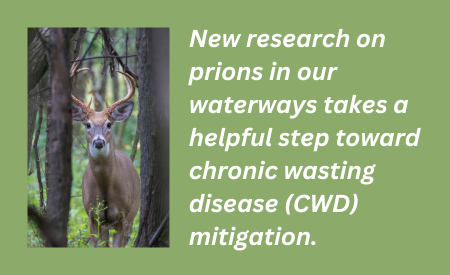
“People in Minnesota value their water,” observes hydrologist Dr. Diana Karwan, an Associate Professor with the Department of Forest Resources. So when the Minnesota Center for Prion Research and Outreach (MNPRO) received a mandate from the state to investigate chronic wasting disease (CWD), many questions from the public and legislators kept returning to the subject of our lakes, wells, marshes, and streams. In response, the team agreed to learn all they could regarding how prions move in waterways, recruiting Dr. Karwan to lead the effort. A January 2024 report to the Minnesota Clean Water Council delivered on that promise.
Land that has seen CWD can store that risk for a very long time, but that doesn’t mean it isn’t going anywhere. Besides movement by animals, researchers hypothesized that prions can be transported by water, potentially increasing their threat. Borne by water, prions might travel to places where CWD had previously been undetected or concentrate in an area where it makes infection more likely. At the end of a two-year study, scientists at MNPRO gained clarity about how prions behave in water. One key insight emerged: prions travel with a partner.
The report revealed how prions in water tend to stick to the soil they encounter. This means that when snowmelt introduces sediment to Minnesota waterways, it could also be carrying CWD. The discovery has positive implications, however. Knowledge that prions tend to bind with particles can guide water resource managers as they assess, and look for ways to mitigate, the risk. It lets them know how to sample waterways for protein-misfolding disease and makes the first steps toward informing accurate models of where water may move CWD throughout the landscape. While the report was being prepared for release, another county was added to the list for CWD detections in wild deer.
The Next Steps
“Now we need to start integrating what we know about CWD behavior with what we know about water behavior. Models allow us to put these knowledge bases together,” says Dr. Karwan. “I feel like what we've done is come up with very important first-point findings. I'm excited to take the next steps with this research.”
To learn more, watch this short video that was made to accompany the report:
~Story by Thomas Seiler, MNPRO. This article originally appeared in the March 2024 MNPRO newsletter and has been adapted for this blog.
Image description: At left is a photo of a male white-tailed deer. It stands amidst several tree trunks and is looking directly at the camera. To the right of that photo is the text, "New research on prions in our waterways takes a helpful step toward chonic wasting disease (CWD) mitigation."
